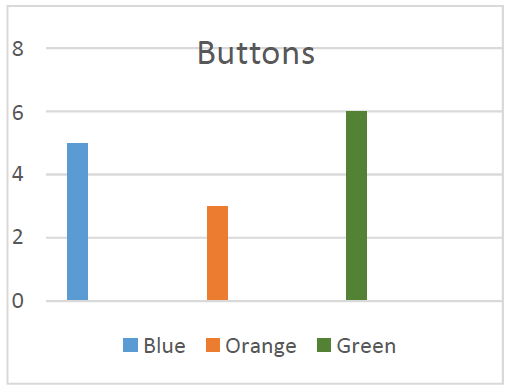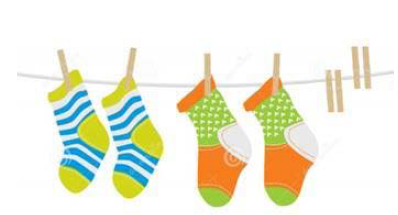Children begin to develop emergent math skills at a very young age. Even babies understand cause and effect, “If I shake this rattle, it makes noise.” Toddlers begin to classify toys. “These toys roll” (balls, trucks), and “these toys do not roll” (dolls, blocks). During the preschool years, children recognize patterns, enjoy sorting objects and classify objects into groups. “His cars are small, and my trucks are large.”

According to the National Association for the Education of Young Children Position Statement on Early Childhood Mathematics,i “Mathematics helps children make sense of their world outside of school and help them construct a solid foundation for success in school.” Children have a natural and spontaneous interest in math as they wonder which items are bigger and sort different toys by type.ii Additionally, numeracy experiences provided by parents at home are predictive of children’s numeracy skills (ordering, classification) in kindergarten.iv
Preschoolers can develop an understanding of numbers, spatial concepts (shapes, measurement) and the ability to sort, classify and solve problems.vi Early childhood teachers support children’s cognitive development by offering intentional opportunities for children to gain a variety of math skills.iii,v
In this fact sheet we focus on the math skills of classification, matching, seriation and patterning.
Classification
Classification is the skill of sorting or grouping items by similar characteristics, such as colors, shapes or sizes. Children naturally classify toys by type and sort crayons by color. Children between the ages of 3 and 4 years old enjoy sorting and classifying objects usually by one characteristic (color, shape or size). If preschoolers do not know the names of colors or shapes, it may be helpful to ask them to find something that is the same color or shape as a specific item. As children develop, they can classify by more than one characteristic, such as sorting the green square blocks.
Preschoolers benefit from exploring a variety of materials and making discoveries. When selecting materials for young children, avoid any small items that could pose a choking hazard. As children explore a bin of rocks and leaves, they can learn which items are big, little, rough, smooth, thick, thin, hard, soft, wet or dry. Children are learning to classify items by similarities and differences.
Ideas to try:
Sorting Pom-poms: Provide children with a variety of pom-poms in different sizes and give them tongs to sort the pom-poms into a small, medium or large container.
Sorting Graph: After sorting items such as leaves, large sea shells or post cards, have the children record the information on a graph or chart. You can create a bar graph by listing the types of objects on the bottom and the number of objects on the side. (See example.)
Button, Button: Children can classify or sort large buttons by color, shape or size. They can sort by the type of button (metal, plastic or cloth) whether the buttons are shiny or dull, or how many holes are in the button. Children could also create a graph to illustrate the different colors or sizes of buttons.

Matching is a simple form of sorting. It is finding items that are the same or alike, such as a pair of gloves. Matching can include finding items with the same specific characteristic (color, size or shape). For example, children can match two items that are the color blue.Matching

Ideas to try:
Match the Socks: Mix up pairs of different colored socks in a basket. Invite children to find pairs of socks that match and hang them up together on a clothesline.
Matching Game: Trace the outline of common objects onto a sheet of paper. Have the children match the object to the corresponding outline on the paper. You could also take pictures from magazines of common items, such as a spoons and cups, and have children find the real object in the kitchen area.
Bunny Tails: Create different colored bunny shapes and use pom-poms for bunny tails in corresponding colors. Children can match the bunny tail to the bunny shape of the same color.
Seriation
Seriation is arranging objects in order by size, location or position. Ordering requires the ability to see differences and compare multiple objects. For example, children in the classroom could be arranged from shortest to tallest, or story picture cards could be sequenced in the order the events happened in the story.
Ideas to try:
Car Race: Children can race cars down a track and then arrange the cars in the order they finished the race from first to last.
Which is Longer?: Give children several crayons of different lengths. Have them put two crayons side by side and then tell you which is longer. Try it with another pair of crayons. Have children put all of the crayons in order from shortest to longest.
Story Time: Using books such as the Three Bears or Three Billy Goats Gruff, children can line up the characters from smallest to largest. They can arrange the Three Bears’ porridge, chairs and beds by size.

Patterning
Children observe patterns at school, at home, at play and in nature. They notice patterns in clothing, songs, nature and even their daily routine. Patterns are sequences that repeat. The ability to recognize patterns supports math skills. It helps children make predictions about what will come next.
The most common pattern is the ABAB pattern: red, blue, red, blue. Other patterns include the ABCABC pattern and AABAAB pattern. For example, circle, square, triangle, circle, square, triangle (ABCABC). Children can create patterns using colors, shapes, sizes or other characteristics that are repeated multiple times.

Ideas to try:
Pattern Blocks: Children can create a pattern with different colors of interlocking blocks. You can also give them picture cards with sample patterns, and children can try to recreate the pattern.
What is Missing?: Create examples of patterns on a piece of paper with fun foam shapes. Leave missing spaces in the pattern and have the children fill in the missing parts with extra fun foam shapes. For example, triangle, rectangle, circle, triangle, __________,circle, and have the child fill in the blank. As children become familiar with making patterns, you can increase the complexity of the pattern or the number of missing parts.
What Comes Next?: Ask children to tell you what comes next as you create a pattern. For example, horse, cat, dog, horse, cat, ________________.
Sound and Movement Patterns: Invite children to create physical patterns, such as clap-clap-hop, clap- clap-hop, or dance a pattern, such as shake, spin and wiggle (repeat).
Conclusion
Teachers can promote math in the early childhood classroom throughout the day by building on everyday activities. Preschool math is about playful exploration and meaningful experiences.
Include items in the classroom and at home that promote mathematical thinking, such as manipulatives, measuring tapes, scales and rulers. Children gain an interest in mathematics by participating in hands-on experiences. It is also important for children to hear language focused on math concepts. Engagement in mathematical experiences helps children gain abilities in making predictions, solving problems, thinking, reasoning and making connections with their world.
References
i National Association for the Education of Young Children and National Council of Teachers of Mathematics. (2010). A joint position statement. Early childhood mathematics: Promoting good beginning. Early Childhood Mathematics: Promoting Good Beginnings
ii Ginsburg, H. P., Lee, J. S., & Boyd, J. S. (2008). Mathematics education for young children: What it is and how to promote it. Social Policy Report: Society for Research in Child Development, 22(1), 1-24.
iiiKirova, A., & Bhargava, A. (2002). Learning to Guide Preschool Children’s Mathematical Understanding: A Teacher’s Professional Growth. Early Childhood Research & Practices, 4(1).
ivKleemans, T., Peeters, M., Segers, E., & Verhoeven, L. (2012). Child and home predictors of early numeracy skills in kindergarten. Early Childhood Research Quarterly, 27, 471-477.
vMcLennan, D. P. (2014). Making math meaningful for young children. Teaching Young Children, 8(1), 20- 22.
viMacDonald, S. (2007). Math in Minutes. Gryphon House: Beltsville, MD.
Buttons size by color
| Color |
size |
| Blue |
5 |
| Orange |
3 |
| Green |
6 |


